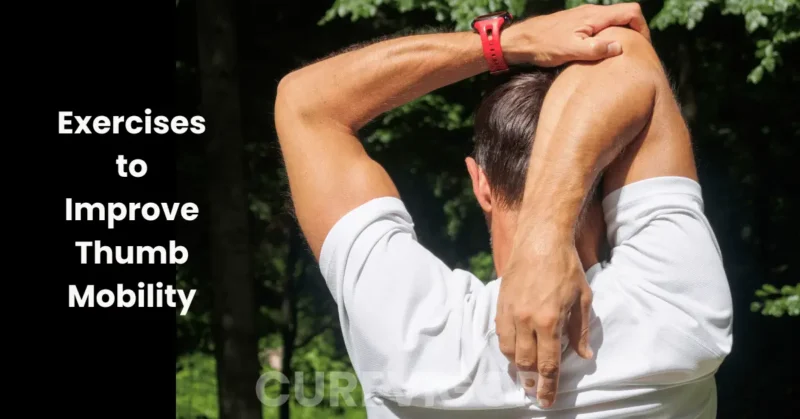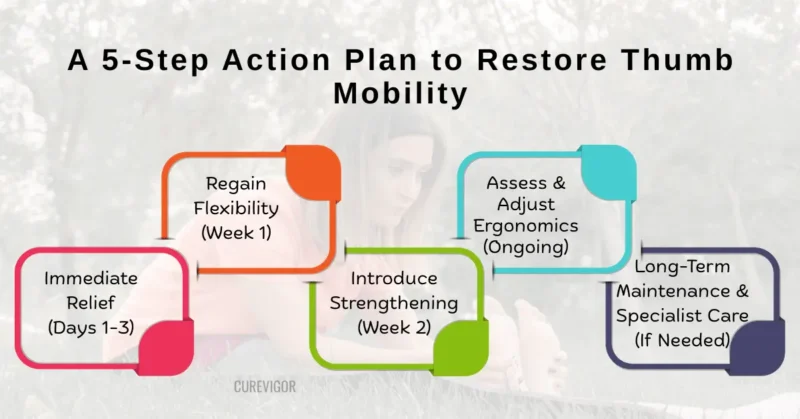Regain control of your hand! Learn how to restore thumb mobility and relieve pain caused by arthritis, strain, or injury. Expert exercises, ergonomic tips, and a 5-step action plan included.
Thank you for reading this post, don't forget to subscribe!Thumb mobility is crucial for everyday activities, but injuries and repetitive strain can limit its range of motion, making simple tasks like gripping a coffee cup feel impossible.
Learn how to restore thumb mobility and alleviate pain with these expert tips and gentle, proven exercises.
This comprehensive guide provides everything you need to know to take back control of your hands and live pain-free.
Short Summary
| Feature | Summary |
| Why it Matters | The thumb accounts for up to 50% of overall hand function. Restricted mobility severely limits daily life. |
| Core Strategy | Gentle stretching (flexibility) followed by progressive strengthening (stability). |
| Common Causes | Arthritis, tendonitis (De Quervain’s), sprains, and repetitive strain (texting/typing). |
| Action Plan | Start with R.I.C.E., introduce mobility exercises, then progress to strengthening, and check your ergonomics. |
| When to See a Doctor | If pain is sharp, swelling is significant, or mobility doesn’t improve after two weeks of home care. |
Definition
Thumb mobility refers to the full, healthy range of motion of your thumb joints, primarily the carpometacarpal (CMC) joint at the base.
Your thumb may move in several planes thanks to this joint: flexion (bending in), extension (bending out), abduction (moving away from the palm), adduction (moving toward the palm), and opposition (touching the other fingertips).
A healthy, mobile thumb is essential for gripping, pinching, and fine motor skills. When mobility is restricted, these daily actions become painful or impossible, signaling an issue that needs attention, whether it’s arthritis, a sprain, or tendonitis.
Understanding Thumb Mobility and Common Issues

What is Thumb Mobility, and Why is it Important?
Thumb mobility is the foundational ability that separates the human hand from that of most other mammals.
It provides the opposable grip required for detailed manipulation. If your thumb is stiff, weak, or painful, you lose significant function.
- Daily Tasks Affected: Writing, buttoning a shirt, opening jars, using a phone, and lifting heavy objects.
- Quality of Life: Reduced independence and chronic pain can negatively impact mood and well-being.
- Functional Percentage: Experts estimate that the thumb contributes nearly 40-50% of the hand’s total functional capacity. Protecting its movement is paramount.
Common Thumb Injuries and Conditions
Limited thumb mobility rarely happens without a cause. Recognizing the root issue is the first step toward effective treatment.
| Condition | Description | Typical Symptom |
| Osteoarthritis | Degeneration of the cartilage in the CMC joint often causes stiffness and a dull, deep ache. | Pain at the base of the thumb, difficulty pinching. |
| De Quervain’s Tenosynovitis | Inflammation of the tendons and their protective sheaths on the thumb side of the wrist. | Sharp pain when gripping or twisting the wrist (e.g., opening a jar). |
| Sprains/Strains | Damage to the ligaments (sprain) or muscles/tendons (strain) due to hyperextension or trauma. | Swelling, bruising, and tenderness often follow a fall. |
| Repetitive Strain Injury (RSI) | damage caused by daily, subtle movements, such as excessive texting or improper use of a computer mouse. | Gradual onset of pain and fatigue in the thumb/wrist area. |
Exercises to Improve Thumb Mobility
Restoring mobility requires a two-step approach: first, gentle stretching to regain flexibility, and second, strengthening to stabilize the joint and prevent future injury. Always start slowly and stop if you feel sharp pain.

Thumb Stretches for Improved Mobility (Flexibility)
Increasing joint range of motion is the main goal of these workouts. Perform these 5-10 times, 2-3 times per day.
- Thumb Flexion and Extension:
- Start with your palm open and flat.
- Flexion: Slowly bend your thumb across your palm, trying to touch the base of your little finger. Hold for 5 seconds.
- Extension: Straighten your thumb back out as far as it comfortably goes.
- Action: Aim for a gentle, non-painful stretch.
- Thumb Opposition:
- Hook the tips of your thumb and index finger to form a circle.
- Move your thumb slowly to touch the tip of your middle finger, then ring finger, and finally, the little finger.
- Action: This targets the muscles responsible for fine motor control and pinching.
- Thumb Abduction and Adduction:
- Place your hand flat on a table, palm up.
- Abduction: Slide your thumb away from your index finger as far as possible (the ‘hitchhiker’ motion). Hold for 5 seconds.
- Adduction: Slide your thumb back against your index finger.
- Action: This addresses side-to-side mobility, crucial for grasping.
Strengthening Exercises for Thumb Mobility (Stability)
Once you have regained some mobility without pain, you can introduce light resistance.
- Thumb Press:
- Place a small lump of modeling clay or putty on a table.
- Gently press the pad of your thumb into the clay, holding the pinch for 5-10 seconds.
- Action: Start with very soft putty; progress to firmer putty as strength improves.
- Rubber Band Thumb Stretch:
- Place a small rubber band around all five fingertips.
- Slowly spread your thumb away from your fingers, resisting the band’s resistance.
- Hold the widened position for 5 seconds, then relax.
- Action: Repeat 10 times. This is excellent for strengthening the muscles involved in abduction.
- Pinch Grip:
- Use a soft stress ball or a large, soft foam block.
- Pinch the object firmly between your thumb and the side of your index finger.
- Hold for 5 seconds, then release.
- Action: This builds the strength needed to grip and hold objects securely.
Additional Tips for Restoring Thumb Mobility

Ergonomic Tips for Thumb Health
Repetitive strain is a major culprit in thumb pain. Adjusting your environment can drastically reduce the stress on your joints.
- Phone Habits: Use voice-to-text features, or hold your phone with one hand and type with the index finger of the other hand. Avoid one-thumb typing for long periods.
- Keyboard/Mouse Placement: Ensure your mouse allows your wrist to rest naturally. Use a trackball mouse or a vertical mouse to keep the wrist and hand in a neutral, handshake position.
- Use Adaptive Tools: Employ jar openers, specialized gripping tools, or large-handled utensils to reduce the force required for daily tasks.
- Relatable Real-Life Example: My grandmother, who has early arthritis, switched to a large, ergonomic kettle handle and can now safely make tea without sharp pain at her CMC joint.
Managing Pain and Inflammation
Immediate pain management is crucial for allowing the tissues to heal and respond to exercise.
- R.I.C.E. Principle (Initial Injury):
- Rest: Avoid activities that cause pain.
- Ice: Three to four times a day, apply a cold pack for ten to fifteen minutes to lessen acute inflammation.
- Compression: A supportive brace or wrap can help stabilize the joint (especially for sprains).
- Elevation: Keep the hand above heart level if swelling is present.
- Over-the-Counter (OTC) Relief: Nonsteroidal anti-inflammatory drugs (NSAIDs), such as ibuprofen, can help manage short-term pain and swelling.
- Heat Therapy (Chronic Pain): For chronic stiffness (like arthritis), a warm soak or heating pad can loosen the joints before exercises.
Personal Insight and Observation
As someone who spends hours typing and using a smartphone, I noticed a dull ache at the base of my thumb a few years ago.
It wasn’t acute pain, just a constant, low-level throb. My observation was this: we often wait for the pain to become severe before we intervene.
I realized my resting posture was poor; I was always holding my phone with the weight resting entirely on my pinky finger while my thumb was outstretched.
I implemented a strict 5-minute break schedule every hour, started using a thumb stretch band before typing, and switched to a vertical mouse.
The result? The pain vanished within two weeks. This experience taught me that consistency in small, ergonomic changes often prevents the need for drastic medical intervention. Be proactive, not reactive.
Mistakes to Avoid When Restoring Thumb Mobility
Avoiding common pitfalls will accelerate your recovery and prevent further damage.
- Pushing Through Sharp Pain: Never force a stretch or exercise that causes sharp, stabbing pain. Sharp pain signals injury; respect the limit. Differentiating between discomfort (good stretch) and pain (bad injury) is vital.
- Neglecting Proper Rest: Trying to continue activities like heavy gardening, texting, or gaming during an inflammatory flare-up will only delay healing and worsen the condition.
- Skipping the Strengthening Phase: Only stretching will make your joint flexible, but unstable. You must incorporate strengthening to stabilize the joint and protect it in the long term, especially to help prevent the progression of arthritis.
- Self-Diagnosing Nerve Damage: If you feel numbness, tingling, or weakness radiating up the arm, do not attempt to self-treat.
This requires immediate medical or physical therapy evaluation to rule out nerve entrapment (like carpal tunnel syndrome).
Practical Checklist for Daily Thumb Health
Use this checklist to ensure you are consistently implementing healthy habits.
- Daily Mobility Exercises: Have I completed my set of flexion/extension and opposition exercises today?
- Strengthening Session: Did I do my pinch grip or rubber band exercises?
- Ergonomic Check: Is my wrist straight while typing, and am I using both hands to text?
- Rest & Ice: Did I apply ice to the painful area if I felt a flare-up?
- Adaptive Tool Use: Did I use my jar opener or larger utensils for high-stress activities?
- Posture Awareness: Am I slumping or putting pressure on my wrists/hands while reading or working?
A 5-Step Action Plan to Restore Thumb Mobility

Follow these steps sequentially for the best long-term outcome.
- Immediate Relief (Days 1-3): Identify and stop the activity causing the pain (e.g., specific repetitive action). Apply the R.I.C.E. principle to manage swelling and pain. Use a supportive, custom-fitted brace if the pain is acute (consult a pharmacist or doctor).
- Regain Flexibility (Week 1): Introduce the gentle Thumb Stretches (Flexion, Extension, Opposition) multiple times a day. Focus only on the non-painful range of motion. Do not use resistance.
- Introduce Strengthening (Week 2): Once pain-free flexibility is achieved, start the Strengthening Exercises (Thumb Press, Rubber Band Stretch) using minimal resistance. Build up reps slowly.
- Assess and Adjust Ergonomics (Ongoing): Evaluate your workplace, home, and device usage. Implement ergonomic tips (e.g., a vertical mouse, two-handed texting) to prevent pain from returning. This step is non-negotiable for long-term health.
- Long-Term Maintenance and Specialist Care (If Needed): Continue the exercises three times a week. If pain persists after 4-6 weeks of dedicated effort, seek professional help (hand therapist, rheumatologist, or orthopedist).
They can offer specialized physical therapy, injections, or further diagnostic tests.
Frequently Asked Questions on Thumb Mobility
Q. How long does it take to restore thumb mobility after an injury?
Recovery time varies significantly depending on the underlying cause. For a mild sprain or repetitive strain injury (RSI), you might see significant improvement in 2-4 weeks with consistent rest and gentle exercise.
However, recovery from tendonitis (like De Quervain’s) or managing chronic arthritis pain can take months.
The key is strict adherence to the exercise plan and immediate cessation of the painful activity. Be patient with your body; healing is a process, not a race.
Q. Can I treat thumb arthritis with exercises alone?
Exercises are a cornerstone of managing thumb arthritis, but they are often insufficient on their own. Mobility and strengthening exercises prevent stiffness and maintain function, but they cannot reverse the joint damage.
A holistic approach is best, combining exercise with anti-inflammatory medications (as directed by a doctor), heat therapy for stiffness, and adaptive devices.
A physical therapist may formulate an exercise program based on your arthritis severity.
Q. What is the difference between a thumb sprain and a thumb strain?
Damage to the ligaments—the robust tissues that unite bones and stabilize joints—causes a sprain (e.g., skier’s thumb).
Damage to a muscle or tendon, the tissues that connect muscle to bone, is referred to as a strain. Both cause pain, swelling, and reduced mobility.
Sprains are generally more serious and often require stabilization or bracing. If you cannot move the joint at all or see visible joint displacement, seek medical attention immediately.
Q. Is texting a significant cause of limited thumb mobility, and how can I prevent it?
Yes, excessive texting, typing, and gaming are major drivers of Repetitive Strain Injuries (RSI) and can lead to conditions like De Quervain’s tenosynovitis.
The repeated, small, fast movements place immense stress on the thumb tendons.
Prevention involves using voice-to-text, using both hands instead of just one thumb, taking frequent breaks every 15 minutes, and holding your device so your wrist stays straight and relaxed. Reduce your overall screen time.
Q. Should I use heat or ice for thumb pain and stiffness?
Use ice (a cold pack) primarily for acute pain, swelling, or flare-ups where you suspect active inflammation (e.g., a new injury or tendonitis). Ice helps numb the area and reduce swelling.
Use heat (a warm soak or a heating pad) for chronic stiffness, especially when waking up or before starting your exercise routine.
Heat increases blood flow, relaxes the muscles, and temporarily improves joint lubrication. Never use heat on a fresh, swollen injury.
Final Thoughts on Restoring Thumb Mobility
Taking the steps to restore your thumb mobility is a powerful act of self-care. It moves you from passively enduring pain to actively taking charge of your health. Remember, the journey requires patience and consistency.
You are not alone in dealing with these issues; millions face similar challenges daily. Start small, be gentle with yourself, and celebrate every increase in your range of motion.
By integrating these simple stretches, strengthening routines, and ergonomic fixes, you can significantly reduce your pain and reclaim the ability to enjoy life’s simple, essential activities.
If you have started the exercises and still experience sharp, unmanageable pain or no improvement after 4 weeks, don’t delay.
Contact a certified hand therapist or your primary care physician today to get a professional diagnosis and a personalized treatment plan.
Read more articles on Health and Balance.
You might like to read:

